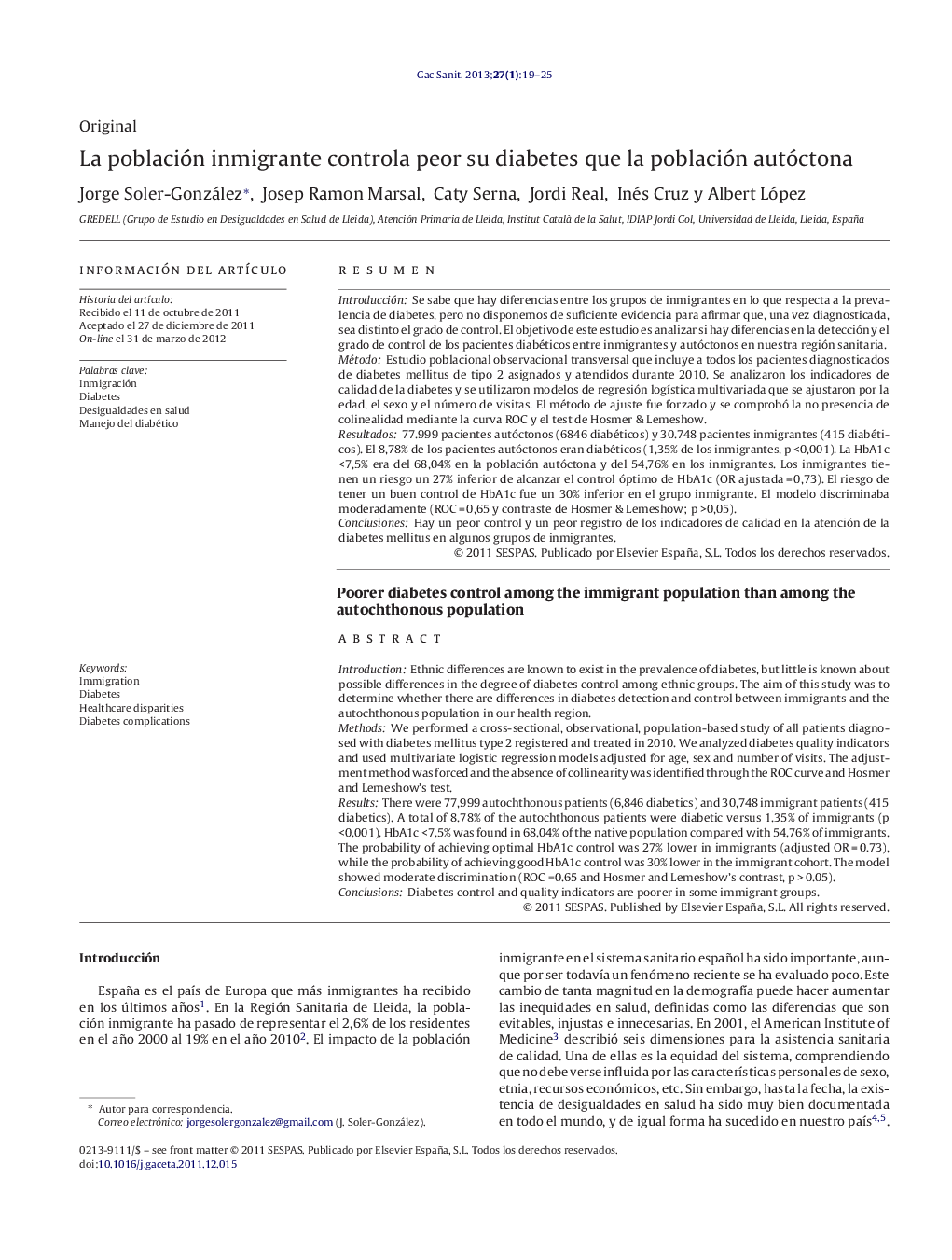| کد مقاله | کد نشریه | سال انتشار | مقاله انگلیسی | نسخه تمام متن |
|---|---|---|---|---|
| 1073528 | 949790 | 2013 | 7 صفحه PDF | دانلود رایگان |

ResumenIntroducciónSe sabe que hay diferencias entre los grupos de inmigrantes en lo que respecta a la prevalencia de diabetes, pero no disponemos de suficiente evidencia para afirmar que, una vez diagnosticada, sea distinto el grado de control. El objetivo de este estudio es analizar si hay diferencias en la detección y el grado de control de los pacientes diabéticos entre inmigrantes y autóctonos en nuestra región sanitaria.MétodoEstudio poblacional observacional transversal que incluye a todos los pacientes diagnosticados de diabetes mellitus de tipo 2 asignados y atendidos durante 2010. Se analizaron los indicadores de calidad de la diabetes y se utilizaron modelos de regresión logística multivariada que se ajustaron por la edad, el sexo y el número de visitas. El método de ajuste fue forzado y se comprobó la no presencia de colinealidad mediante la curva ROC y el test de Hosmer & Lemeshow.Resultados77.999 pacientes autóctonos (6846 diabéticos) y 30.748 pacientes inmigrantes (415 diabéticos). El 8,78% de los pacientes autóctonos eran diabéticos (1,35% de los inmigrantes, p <0,001). La HbA1c <7,5% era del 68,04% en la población autóctona y del 54,76% en los inmigrantes. Los inmigrantes tienen un riesgo un 27% inferior de alcanzar el control óptimo de HbA1c (OR ajustada = 0,73). El riesgo de tener un buen control de HbA1c fue un 30% inferior en el grupo inmigrante. El modelo discriminaba moderadamente (ROC = 0,65 y contraste de Hosmer & Lemeshow; p >0,05).ConclusionesHay un peor control y un peor registro de los indicadores de calidad en la atención de la diabetes mellitus en algunos grupos de inmigrantes.
IntroductionEthnic differences are known to exist in the prevalence of diabetes, but little is known about possible differences in the degree of diabetes control among ethnic groups. The aim of this study was to determine whether there are differences in diabetes detection and control between immigrants and the autochthonous population in our health region.MethodsWe performed a cross-sectional, observational, population-based study of all patients diagnosed with diabetes mellitus type 2 registered and treated in 2010. We analyzed diabetes quality indicators and used multivariate logistic regression models adjusted for age, sex and number of visits. The adjustment method was forced and the absence of collinearity was identified through the ROC curve and Hosmer and Lemeshow's test.ResultsThere were 77,999 autochthonous patients (6,846 diabetics) and 30,748 immigrant patients (415 diabetics). A total of 8.78% of the autochthonous patients were diabetic versus 1.35% of immigrants (p <0.001). HbA1c <7.5% was found in 68.04% of the native population compared with 54.76% of immigrants. The probability of achieving optimal HbA1c control was 27% lower in immigrants (adjusted OR = 0.73), while the probability of achieving good HbA1c control was 30% lower in the immigrant cohort. The model showed moderate discrimination (ROC =0.65 and Hosmer and Lemeshow's contrast, p > 0.05).ConclusionsDiabetes control and quality indicators are poorer in some immigrant groups.
Journal: Gaceta Sanitaria - Volume 27, Issue 1, January–February 2013, Pages 19–25